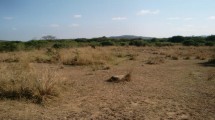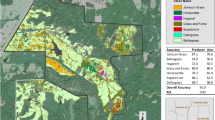Summary
We studied factors which may shape giving-up decisions of wapiti grazing grassland patches (area where a wapiti initiates and terminates a feeding sequence) and feeding stations (area within a patch that a wapiti can reach without moving its forelegs). In grassland patches, cropping rate decreased after a critical period, whereas at feeding stations cropping rate increased with cumulative bites consumed. The number of feeding stations grazed, number of bites taken and grazing time did not dictate the termination of grazing in a patch. Wapiti gave up a patch only after the cropping rate at a feeding station dropped below the seasonal expectation during trials on lush pasture in May, but gave up after the cropping rate dropped below the seasonal expectation at two consecutive feeding stations in March/April and August when foraging conditions were less favourable. This confirmed a prediction of the marginal value theorem. Wapiti did not give up a feeding station according to bites taken, grazing time or cropping rate, but they left feeding stations when their lateral neck angle reached a critical point suggesting a biokinetic explanation. Leaving feeding stations when ungrazed forage can no longer be reached and patches when intake rate drops both appeared to be rules used by wapiti grazing grasslands of the boreal mixed wood forest.
Similar content being viewed by others

References
Association of Official Analytical Chemists, AOAC (1984)Official Methods of Analysis, 14th edition, pp. 957. Association of Official Agricultural chemists, Washington, DC, USA.
Charnov, E. L. (1976) Optimal foraging, the marginal value theorem.Theor. Pop. Biol. 9, 129–36.
Cowie, R. J. (1977) Optimal foraging of Great Tit (Parus major).Nature (London) 268, 137–9.
Gates, C. C. and Hudson, R. J. (1983) Foraging behavior of wapiti in a boreal forest enclosure.Nat. Can. 110, 197–206.
Goering, H. K. and van Soest, P. J. (1970) Forage Fiber Analyses (Apparatus, Reagents, Procedures and Some Applications). United States Department of Agriculture, Agriculture Handbook No. 379.
Holling, C. S. (1959) Some characteristics of simple types of predation and parasitism.Can. Entomol. 7, 385–98.
Hodges, C. M. (1981) Optimal foraging in bumblebees: hunting by expectation.Anim. Behav. 29, 1166–71.
Iwasa, Y., Higashi, M. and Yamamura, Y. (1981) Prey distribution as a factor determining the choice of optimal foraging strategy.Am. Nat. 117, 710–23.
Jiang, Z. and Hudson, R. J. (1992) Estimating forage intakes and energy requirements of free-ranging wapiti (Cervus elaphus).Can. J. Zool. 70, 675–9.
Jiang, Z. and Hudson, R. J. (1993) Foraging postures of wapiti (Cervus elaphus).Appl. Anim. Behav. Sci. (in press).
Kadmon, R. and Shmida, A. (1992) Departure rules used by bees foraging for nectar: a field test.Evol. Ecol. 6, 142–51.
Krebs, J. R. and Inmant, A. J. (1992) Learning and foraging: individuals, groups and populations.Am. Nat. 140, S63–84.
Krebs, J. R., Houston, A. I. and Charnov, E. L. (1981) Some recent developments in optimal foraging. InForaging Behavior, Ecological, Ethological, and Psychological Approaches (A. C. Kamil and T. D. Sargent, eds), pp. 3–18. Garland STPM Press, New York, USA.
McNair, J. N. (1982) Optimal giving-up time and the marginal value theorem.Am. Nat. 119, 511–29.
Novellie, P. A. (1978) Comparison of the foraging strategies of blesbok and springbok on the Transvaal highland.South Africa J. Wildl. Res. 8, 137–44.
Pleasants, J. M. (1989) Optimal foraging by nectarivores: a test of the marginal-value theorem.Am. Nat. 134, 51–71.
Senft, R. L., Coughenour, M. B., Bailey, D. W., Rittenhouse, L. R., Sala, O. E. and Swift, D. M. (1987) Large herbivore foraging and ecological hierarchies.BioScience 37, 789–99.
Sokal, R. R. and Rohlf, F. J. (1989)Biometry, 2nd ed, pp. 421–3, p. 509. W. H. Freeman and Company, New York, USA.
Author information
Authors and Affiliations
Rights and permissions
About this article
Cite this article
Jiang, Z., Hudson, R.J. Optimal grazing of wapiti (Cervus elaphus) on grassland: Patch and feeding station departure rules. Evol Ecol 7, 488–498 (1993). https://doi.org/10.1007/BF01237643
Issue Date:
DOI: https://doi.org/10.1007/BF01237643



